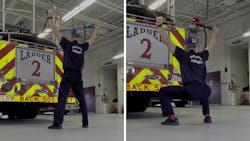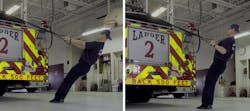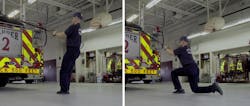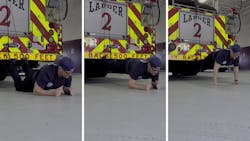Health & Wellness: Suspension Bodyweight Training for First Responders
This is the year that you and your crew at the department make the commitment to get fit, right? After all, as first responders, health and fitness should be one of your main priorities.
With that in mind, I challenge you and your crew to start off 2022 on the right foot by hanging around at the gym—and by hanging, I mean by trying suspension bodyweight training.
Suspension trainers are a series of ropes, usually that have handles, that suspend from a fixed anchor point, such as a doorway, wall, squat-rack or even a sturdy handle on the engine. The most notable system, TRX, was invented by a Navy SEAL who was on deployment in the Gulf War. He and his team needed to stay combat-ready. With no access to strength-training equipment, he improvised the first suspension trainer out of parachute chord and webbing.
Suspension training is a form of leveraged bodyweight training. The system utilizes gravity and the user’s bodyweight to provide resistance in various movement patterns. Its programming principles are unique in that either the user’s hands or feet are supported by a single anchor point while the opposite side of the body is in contact with the ground. By changing the angle of the body, the user can load the appropriate amount of bodyweight to the user’s level of fitness and strength.
As first responders, we need functional strength in all planes of motion and on unstable ground. We lift, drag, pull and push while we twist and stand in varied stances and postures. Because the suspension trainer uses muscle groups, as opposed to isolated muscles, it reinforces muscle-firing sequences. Therefore, it strengthens the body for movements that we do on the fire/rescue scene, which makes it functional, unlike an isolated up-and-down bicep curl. Exercises will have a greater carryover to movements that you perform in your day-to-day life.
This is something that you feel from the very first exercise that you perform. In fact, you don’t have to think about it. There are increased muscular demands instantly, which you can’t get when you use a machine or free weights. For example, while doing a suspension chest press, you are suspended in a forward incline while on your toes. Your quads, butt, core and back all work while you do those presses.
To create any movement, multiple muscles, particularly the core muscles, must contract to stabilize and balance. This helps to stabilize the spine and joint stabilizers. As these muscles get stronger and more endurant, the body’s capability to steady itself in challenging, unbalanced positions increases. The resulting increased ability to balance oneself correlates directly to increased performance in every movement on (and off) the fireground and decreases the possibility of injury.
Versatile and fun
A third benefit: Suspension training is safe and highly effective for people who are of all levels of fitness. Users easily can vary the level of resistance of any exercise by readjusting their body closer to or farther from the suspension trainer’s anchor. Unlike a barbell, dumbbells or machines that are heavy and bulky to move, suspension trainers are light and portable, and you can perform more than 70 exercises in a small space.
Finally, suspension trainers are fun. They keep workouts interesting. You can change the dynamics of a workout continually with slight changes in grip or stance.
To perform suspension training, you need a suspension system (ropes, webbing, straps) and an overhead anchor point. You can create your own system, but I recommend spending a little bit of money to buy a complete system. They are safer and more durable than one that you could create and have easy ways to adjust the length.
If you aren’t sold that suspension training is effective, here is a quick workout that you should try to give it a test. I perform this workout in the bay and attach a suspension system to the back of the ladder truck.
Before you start, there are two important points to emphasize about form:
Safety first. Make sure that the floor is free of debris and moisture to ensure that your feet don’t slip and cause injury. You also want to make sure that the suspension trainer is anchored properly, so it won’t slip or break during the workout.
Monitor posture. Make sure that your head and shoulders always are in proper alignment and posture, including as you fatigue and, thus, exert more effort.
Warmup
This workout, like every workout that you perform, should start with an active warmup. I simplified this to just one move, the spiderman with rotation.
Start in a pushup position and step your right leg out toward your right hand. Pause for a second and then reach your right hand toward the ceiling. Hold this position for 2–3 seconds and then return to the starting pushup position. Alternate sides and perform five reps on each side.
For this circuit, you perform each exercise as many reps as you can for one minute. You can rest at any point during the minute if needed, particularly if you feel that your form is suffering. After the minute, rest for 30 seconds, and then perform the next exercise.
If this is the first time that you use suspension exercises, just perform this circuit once. If you are more advanced in your level of fitness, challenge yourself to complete 2–3 rounds.
Here are the five exercises:
Suspension squats/arms up. This is a great exercise to work the legs and the postural muscles of the upper back.
Stand facing the anchor point. Extend your arms overhead wider than shoulder width. Keeping your back naturally arched and your arms up, push your hips back, bend your knees and lower your body until the top of your thighs are parallel to the floor. Pause then push yourself back up to the start. Be sure to stand up straight between reps and to focus on keeping your arms straight through the entire motion.
Suspension rows. The row exercise targets all of the major muscle groups of the back, the shoulders and the core. All of these muscle groups are important for improving posture and strength for pulling hose and lifting patients.
Face the anchor point and grab the handles with your palms facing each other. Stand with your feet hip-width apart and lean back until your arms are straight. The position of your feet will determine how difficult the exercise is: Moving them toward the anchor point increases how much that you lean back, which increases difficulty. Pull your chest up between your hands, keeping your elbows close to your body. Pause at the top of the move then slowly lower until your arms are straight.
Suspension chest press. This isn’t the traditional chest exercise with which you might be familiar. The suspension system challenges your body in conditions of instability. This forces you to constantly engage your core and forces your shoulders to stabilize.
Grab the handles and face away from the anchor point. Lean forward until your body is at a 45–60-degree angle, with your arms extended straight. Keep your body straight from head to toe and slowly lower your upper body, bending at the elbows until your chest reaches handle level. Pause for a second and then push through the handles to straighten the arms and return to the starting position.
Suspension lunges. This is a great exercise to improve lower body strength and balance. You can use the arms to assist through the motion and change your foot position to focus on different muscle groups of the lower body.
Face the anchor point and hold the handles at chest height. Step back with one leg bending and lowering the hips to a 90-degree bend. You can rest your back foot on the ground or, for more of a challenge, let it hover just above the ground. Pause in this bent-knee position, make sure that you maintain balance and then return to the starting position by driving through the heel while extending the hips. Alternate from side to side. Make sure to keep your back straight and the chest lifted through the entire motion.
Suspension plank. This takes the plank exercise to a new level. By placing your feet in the handles, your core must work harder to stabilize and perform the exercise.
Work your feet into the handles that are hanging about a foot from the floor. Walk out with your hands, so your body is fully lengthened and in a pushup position. Beginners should just focus on holding this pushup/plank position. For a little more challenge, slowly lower your weight to your forearms. Hold this position until your hips start to sag and then walk back with your hands and remove your feet from the handles.
About the Author
Aaron Zamzow
Aaron Zamzow is a firefighter/training officer for Madison, WI, Fire Department. He holds a bachelor’s degree in health/wellness and has 20 years of experience as a fitness trainer. He created Fire Rescue Fitness and authors programs that are aimed at getting fire rescue athletes fit for duty.





